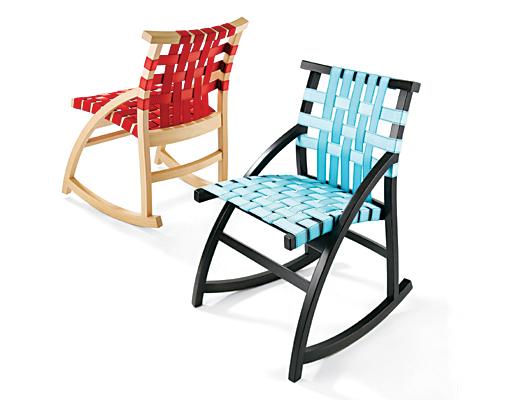Famous furniture designer uses materials that ‘Obviously Manifest Green’

Furniture designer Peter Danko creates environmentally-friendly products such as these chairs made from recycled seatbelts.
April 19, 2011
Furniture designer Peter Danko spent a week at Iowa State lecturing on the importance of being environmentally-friendly.
“Everyone says that they want to be green, but no one really does it,” Danko said. “I guess my whole belief is that there are an awful lot of things we can do.”
In his quest to make America more “green”, Danko designs furniture out of molded plywood and other environmentally-friendly materials. He challenges himself to make furniture from materials that Obviously Manifest Green, which are materials that can be easily seen to be “green.”
“When people buy things, we buy it because of the emotional connection,” Danko said. “My whole thing is about making a style change toward something more environmentally friendly.”
Although he is a furniture designer now, Danko originally went to college to become an illustrator. He earned a bachelor’s degree in fine arts and art history from the University of Maryland,
After college, Danko began carving claws for coat racks in a clothing store.
“That’s how I started woodworking, and I perfectly loved it,” Danko said. “I was really attracted to the smell of the wood and the smell of the woodshop.”
Danko soon became interested in designing chairs. He said his fascination with chairs is due to their complexity.
“You’ve got structure, and then you’ve got of course aesthetics,” Danko said. “You’ve got economics because, you know, you’ve got to make it.”
Eventually, Danko opened up his own shop near Georgetown University in Washington D.C. While there, he visited a factory that made things out of molded plywood.
“They would make these big sheets of plywood out of this beautiful material, and then they would cut it up into little pieces, and put it together like they put together solid wood chairs,” Danko said. “This kind of plywood is not at all like the kind of plywood you buy at Home Depot or Lowes, this is really fine quality wood.”
Danko decided to start making chairs out of molded plywood. The molded plywood Danko uses is thin layers of laminated wood glued together with environmentally-friendly adhesives. He said molded plywood uses resources nine times more efficiently than solid wood.
“Molded plywood is sort of a relatively new medium,” Danko said. “They’ve only been making furniture out of it until, well really, less than a hundred years, and solid wood has been around for thousands of years.”
Architects and interior designers are Danko’s main market. He said he has designs in hotels, schools and even dorms.
“I’ve done a lot of university work,” Danko said. “I’d like to do the University of Iowa, but I guess I should show them my work first.”
Although his favorite chairs are the ones he constructs with molded plywood, Danko said his most popular chairs are the ones that he makes with solid plywood and recycled seatbelts.
“I think that the reason [why they’re the most popular] is because people like solid plywood,” Danko said. “They just don’t consider [molded plywood].”
Danko is currently working on his NoCO2 design, which is furniture made from automobile tires. He is also working on a machine that puts edges on plastic quickly and easily.
In the future, Danko plans on finishing his kitchen, which he has been working on for about a dozen years. He said his kitchen uses 20 percent of the wood used in a normal kitchen and is 30 percent of what a normal kitchen weighs.
“There’s less than half of the material used in a normal kitchen, and everything is recyclable,” Danko said. “It’s just totally different as far as resource consciousness; it’s really different.”
Danko said he believes people will eventually become more sustainable and environmentally-friendly. This belief is due to the fact that people today are much more aware of their environmental impact.
“We want everybody to have a higher standard of living, but we have to change how we use resources,” Danko said. “It just makes sense.”
















